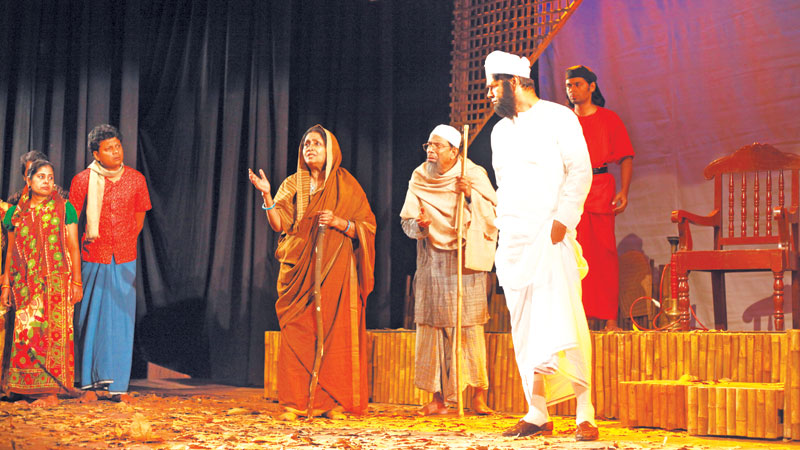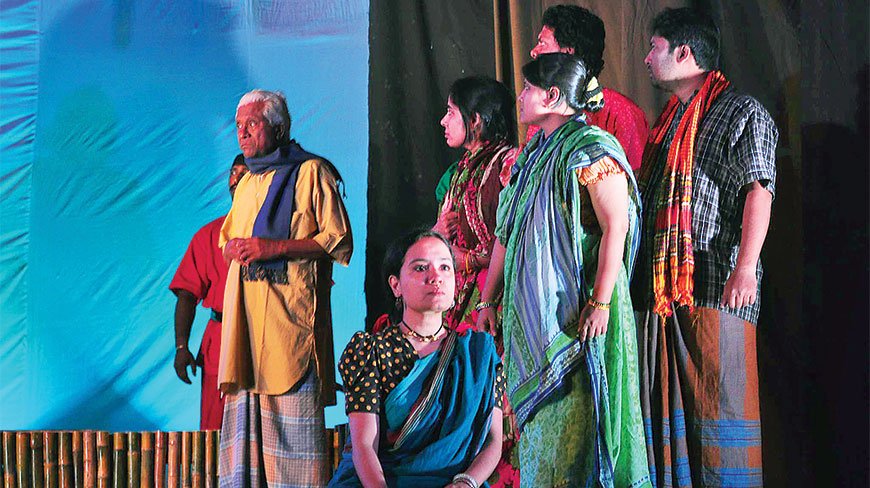When one considers the historical background of the Bangladesh Liberation War, also known as the armed upheaval spearheaded by Bengali nationalists in 1971 in an attempt to secure freedom and autonomy for Bangladesh (then East Pakistan), Syed Shamsul Haque’s evocatively written play Payer Awaj Pawa Jai (At The Sound of Marching Feet) immediately comes to mind.
The movement included a diverse range of East Pakistanis, such as militia and citizens, who rose with arms and filled the streets in opposition to West Pakistan’s oppressive regime over the linguistically and regionally distinct East Pakistan, two different territories of the same nation, Pakistan.
The movement for Bengali rights began immediately after Pakistan’s inception as a country, divided into two sections called West Pakistan and East Pakistan, which we know today as Pakistan and Bangladesh respectively. The unwillingness to acknowledge Bengali as an official language of Pakistan and the erasure of it from academic use in the early years after the partition of India and Pakistan, financial inequity between the two territories, the despotism of the West Pakistani political elite over Pakistan, military laws, a distasteful attitude towards Bengali culture, and the ultimate suppression of the Bengali-speaking Muslim community made a significant contribution to fear and anger, giving rise to the armed fight for liberation.
The play Payer Awaj Pawa Jai written by Syed Shamsul Haque is a verse play that explores the terrible slaughter and mass rapes perpetrated by the militant forces against the Bengali speaking Muslim community amidst Bangladesh’s liberation struggle.

The setting for the narrative is a village in East Pakistan. The performance opens in the courtyard of a district’s headman, with people forming the chorus, many of whom do not talk but rather use movement to capture the spirit of the event. The villagers claim that Bangladeshi “partisans” are approaching from the East, and the village women and children gathered there have come to seek the sanctuary of the headman. As they hear the footsteps of freedom fighters approaching in the distance, the villagers turn to the village’s headman.
The drama also unabashedly depicts a woman’s role in challenging power and the traumatic aspects of engaging in resistance as a woman. The character of the headman’s daughter brings to light an essential feature in which the legitimacy of organised religion and priests is called into doubt. When the Priest tells her that she cannot question God or religion, she boldly asks how it is fair that people in positions of authority may do all manner of sins in the name of God
The headman and his colleague, a priest, attempt to deceive the villagers into believing that Pakistani military personnel are their guardians and that the rebels are on the edge of defeat. The headman’s daughter then reveals that her father dishonoured her by handing her over to a military commander through false marriage. The military officer abuses his power and superior authority to coerce the headman, leading to a fake marriage. The officer then uses brute force on her on the wedding night and then flees the scene the next day, taking advantage of their anxiety.
Throughout the play, the role of institutionalised religion in the oppression of the marginalised Bengali community is highlighted through several characters. While the headman and the priest represent the village’s elite powerful strata and the metaphorical “umbrella” they believe protects them due to their loyalty to the military and the oppressive, tyrannical, and hyper-nationalist state, the headman soon realises that he’s not exactly safe despite his blind loyalty.
When the military commander threatens to rape his daughter if he doesn’t willingly give her away, his illusion of being protected shatters. It is implied that his desire to maintain his power and status has led him to betray his own people in the village and cost him his “honour“.

As corrupt leaders frequently do, we see the headman employ several diversionary methods, and lies. He meticulously manipulates facts through wordplay. For the major section of the play, even the priest is anything but straightforward. When the villagers plead for protection and demand the truth from the headman, the priest goes round and round, providing abstract answers and evading any real responsibility.
Sudip Chakroborthy, a theatre professional based in Bangladesh who took over the play in 2012 and redesigned its production, describes the character of the priest as an illustration of charlatans in real life and religious leaders who attempt to influence the general populace by conveying distorting religious speeches for their personal gain.
The final obvious motif is the shift of power depicted through the means of light and stage direction. The playwright brilliantly portrays the transfer of power from the elite oppressors, i.e., the headman and the priest, to the common people of the village and their resistance
The drama also unabashedly depicts a woman’s role in challenging power and the traumatic aspects of engaging in resistance as a woman. The character of the headman’s daughter brings to light an essential feature in which the legitimacy of organised religion and priests is called into doubt. When the Priest tells her that she cannot question God or religion, she boldly asks how it is fair that people in positions of authority may do all manner of sins in the name of God.
The play demonstrates her one final act of rebellion against the repressive dictatorship and patriarchy in the form of her death by suicide. However, it is for the spectators and readers of the play to question if death was the only way the headman’s brave daughter’s narrative could have garnered the attention, empathy, and anger her fate deserved. The act of the headman’s daughter refusing to go inside when she is scolded illustrates the condition of millions of women whose voice is confined and autonomy is repressed in a phallocentric society.
“Allah? Shey kemon? Kemon tar chehara? (Allah? What does he look like?)” asks the headman’s daughter. Her concern is not an attempt to disrespect a religion, but rather a legitimate query voiced by an innocent girl. She always had learned just what the priest told her. She never delved into the implications, and rather, has led her life having faith in the sermons of the priest. However, that changes when she realises she can no longer trust those who were always supposed to be truthful.

Tropa Majumdar, a seasoned performer, characterises the headman’s daughter as “on the edge but still bold.” She adds, “A girl who doesn’t see the light of hope and who is usually introverted, shouts out her agony to the villagers. She boldly comes out of the house and accuses her father. This is the beauty of the character.“
Another key subject that can be observed is the disparity in attitudes toward authority between young and old villagers. While the youth are direct, fearless, anarchic, and have no tolerance for the authority’s ambiguous word spinning, the older generation of villagers is more timid, compliant, and subservient even while questioning. It is only towards the end that the threshold of the older villagers for the headman’s lies and manipulation is reached, and they seek vengeance and justice.
As he mourns the death of his daughter, the priest accuses the headman of lacking faith. The sound of marching feet is used by the headman once more to influence and distract the villagers who are set upon vengeance for the headman’s deception. The villagers are outraged and demand the headman’s execution.
While the headman tells a story about his father foreseeing his own demise, there’s an explosion. We observe the body of the headman and the bodyguard wiping blood from his sword. At the end, the partisans can be seen to have taken over the stage and the stage direction focuses on the headman’s corpse, the face of the priest, and the national flag.
Also read: Nationalism And Motherhood As Symbols In J.M. Synge’s Evocative Play ‘Riders To The Sea’
The final obvious motif is the shift of power depicted through the means of light and stage direction. The playwright brilliantly portrays the transfer of power from the elite oppressors, i.e., the headman and the priest, to the common people of the village and their resistance.
Perhaps, the beauty of Haque’s writing lies in the fact that this play’s relevance and genius can be comprehended even today, after several decades of its inception. His boldness is reflected in his writing as well as his characters as he aptly portrays the Bangladeshi resistance.
Featured Image: Still from the enactment of Payer Awaj Pawa Jay re-directed by Sudip Chakroborthy, published in Dhaka Tribune
About the author(s)
Poulomi is a Master's scholar from Jamia Millia Islamia, New Delhi, who loves to scribble poetry and write essays just when she can't seem to hold it all in. Her research interests include feminist studies, postcolonial theory, trauma and disability studies. She is very eager to read anything she can get her hands on, when she is not obsessing over spicy food or sleeping





